
Acquisition budgets
Acquisition budgets increased year by year in this decade, from $2.5 million in 1992 to $3.5 million in 1997 and then $5 million in 2001. Despite this, the Library’s purchasing power for collection development was effectively static for much of the time as ongoing currency fluctuations and increases in journal prices impacted on acquisitions.
To cushion the effect of changes in the value of the Australian dollar, from 1993 the University allowed the Library to deposit a substantial proportion of the journals’ budget (in US dollars and pounds sterling) in a foreign currency bank deposit.
In 1996, financial constraints made a journals cancellation project necessary and subscriptions for a number of low use journals were cancelled after extensive investigation and consultation with academics.
Journal purchases were increasingly linked to subscriptions to electronic full-text journal indexing databases, rather than to print runs of journals. Print and electronic versions co-existed but by 1998, when the Library was subscribing to over 150 journal databases, it was clear that the future lay in electronic access to journals. In 1990 the Library held about 5 000 journal titles and by 2001 this had grown to over 15 000.
The number of books in the collection grew significantly in this decade also, rising from around 364 000 in 1989 to over 584 000 in 2001.
Electronic information
Over the 1990s, the roll-out of electronic information resources and services and the provision of state-of-the-art technology, which clients now take for granted, positioned the Library at the cutting edge of collection development and service delivery.
Journals on CD and online
The first journal indexing databases on compact disc for client use were installed in Robertson Library in 1989. In 1991, the first database offering full text of journal articles (Business Periodicals On Disc) proved so popular that it was often booked days ahead. The Electronic Information Centre on level three of Robertson Library was established.
The Library was quick to take up products as they became available. By the end of 1991, 19 databases were on offer, 13 of which were networked to allow for access by multiple users. One year on, 65 databases were available.
Library patrons could also gain online access to scores of Australian and overseas electronic databases via the Australian Academic and Research Network (AARNET). 6
In 1997, a big advance in access was achieved when the Library installed an Electronic Research Library server. This allowed clients to access the journal databases remotely via the Internet, whether they were on campus or at home, via the University's remote access dial-up services.
By the time the Electronic Information Centre was expanded in the refurbishment of 1998, over 150 journal databases were available to clients, many in full text and able to be networked.
Digital theses project
Curtin Library played an active role in the Australian Digital Theses project which started in 1997 and which encompassed both the retrospective scanning of printed theses and the self deposit by current students of their theses in digital format. By standardising the descriptions of theses and their formats, the distributed database of records could be searched via a common search tool available on the Internet.
Library staff progressed the technical aspects of the project and worked with the University’s Office of Research and Development to gain crucial support from the University and its postgraduate students. By October 2002, it was clear that Curtin was a leader in the project, with about 200 Curtin theses in the national database, making up nearly 30% of the total.
The Library’s vision for the John Curtin Prime Ministerial Library (JCPML) included from the start the creation of a digital archive, the Electronic Research Archive (ERA). When ERA went live on the Internet in 1999, it provided worldwide access to digitised content in its own collection as well as bringing together in a seamless manner digitised copies of records held elsewhere. At this time, the JCPML and Curtin Library were recognised nationally and internationally for their pioneering work in the area of digital archives. 7
The collection was managed using Archive Manager and the web access platform used Excalibur’s Retrievalware.
From the beginning the JCPML was technologically advanced. Under the Premier Partnership Agreement with ExLibris, the Library worked collaboratively with the company to develop its digital asset management system Digitool to suit management of the digital archive. In 2003, ERA migrated to the new Digitool platform with significantly improved functionality for clients as well as work flow efficiencies for Library staff.
E-Reserve project
The Library began providing electronic access to reserve items in 2000 and the initiative provided obvious benefits for both students and teaching staff. 10 By the middle of 2002, the e-Reserve system contained over 6 000 documents required in more than 300 units. The materials digitised were primarily high-demand book chapters, journal articles and conference papers.
Other collections
In 1993, a Curtin authors’ collection was created.
The Curriculum Resources Centre, established in 1975 to support education students on practicums, became the Teaching Resources Library in 1995. The refurbished facility was officially opened in April 1996 by Professor Watts, Dean of Humanities.
In 1996 Curtin was the lead university in a consortium of six institutions working on an ARC funded research project ‘South Asia: Renovating the National Collection Project’. As part of the project, a researcher surveyed the national collection and created a database of South Asian holdings which was located at Curtin Library.
While the bulk of the Library’s collections were held at Robertson Library, the development of collections at off-campus branch libraries (Graduate School of Business Information Centre in the Perth central business district, Therapy Library at Shenton Park, and Kalgoorlie Campus Library) continued over the 1990s alongside improvements in their facilities and the services offered to clients.
Services to Curtin International College
The Library commenced providing services to Curtin’s International College in 2000, under an agreed funding arrangement.
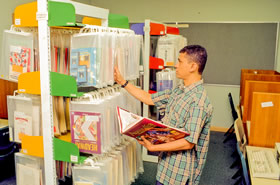 Audiovisual material in special packaging and shelving in the Library, c 1992.
Audiovisual material in special packaging and shelving in the Library, c 1992.
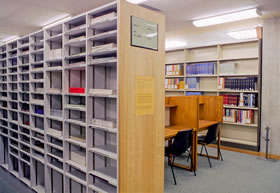 Shelving for recently received issues of journals, c 1992.
Shelving for recently received issues of journals, c 1992.
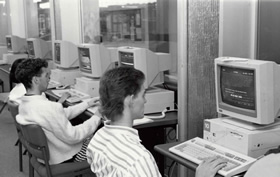 Clients using networked journal indexing databases in the Electronic Information Centre on level three in the early 1990s.
Clients using networked journal indexing databases in the Electronic Information Centre on level three in the early 1990s.
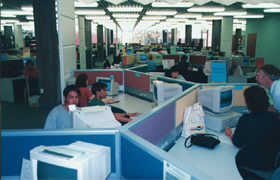 The refurbished Electronic Information on level three, 1999.
The refurbished Electronic Information on level three, 1999.
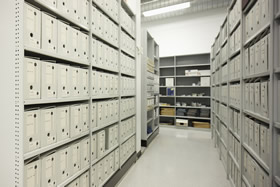 The archival stack area of the JCPML photographed in 2011.
The archival stack area of the JCPML photographed in 2011.
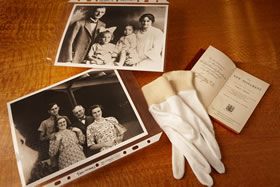 Photographs of John Curtin's family from the JCPML collections.
Photographs of John Curtin's family from the JCPML collections.
Images, searchable full text, and by 2001, audio and video of thousands of archival records in the JCPML were made accessible online via the Electronic Research Archive..
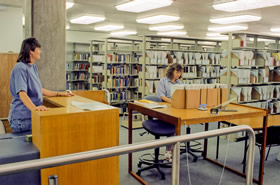 The reserve collection on level two, c 1992.
The reserve collection on level two, c 1992.
Conversion from paper copies to digitally available e-Reserve items provided improved access for clients as well as significantly reducing the space taken up by the reserve collection.
